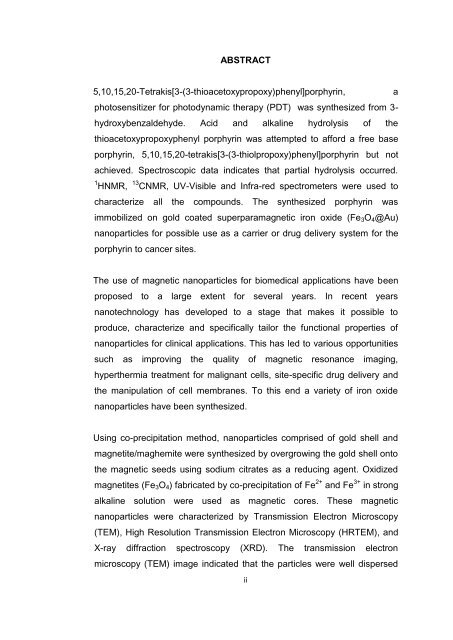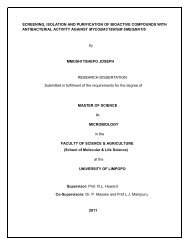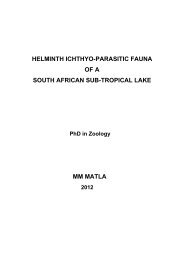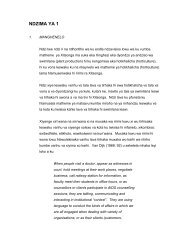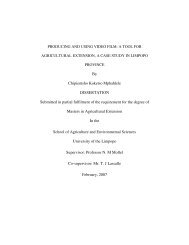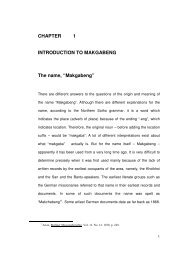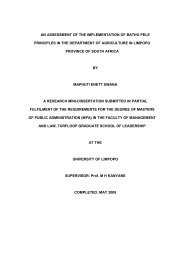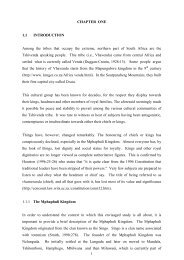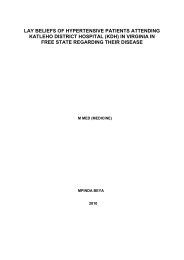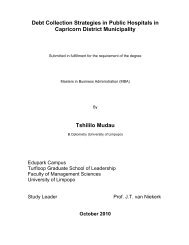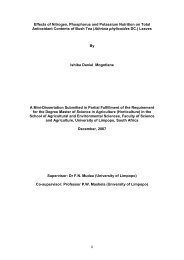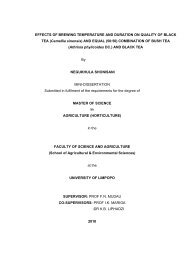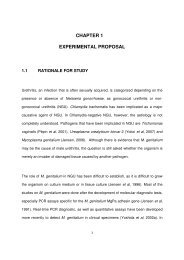- Page 1: Synthesis, Characterization and Kin
- Page 5 and 6: DECLARATION I, Eshilokun Adeolu. O
- Page 7 and 8: ACKNOWLEDGEMENTS It gives me a grea
- Page 9 and 10: I wish to also express my profound
- Page 11 and 12: shown by the kind of friends he cho
- Page 13 and 14: Bros. Afis, Rasaq and Musiliu as we
- Page 15 and 16: MRI Magnetic Resonance Imaging FFs
- Page 17 and 18: Table of Schemes xvii 1 Synthesis o
- Page 19 and 20: 30 (b) Spectra showing the aromatic
- Page 21 and 22: Table of equations 3 S* + 3 O2 10 5
- Page 23 and 24: 1.10 Improvements for PDT 31 1.10.1
- Page 25 and 26: 3.3.11 Magnetic properties of iron
- Page 27 and 28: Chapter 7 References 177 Appendix x
- Page 29 and 30: Paper Presented: Synthesis and Char
- Page 31 and 32: 1.4 Palliative chemotherapy Palliat
- Page 33 and 34: of heat, is also being studied for
- Page 35 and 36: the radiation delivery method, seve
- Page 37 and 38: 1.7.1 Cryosurgery During this type
- Page 39 and 40: 1.7.8 Stereotactic Surgery The proc
- Page 41 and 42: Photodynamic therapy (PDT), matured
- Page 43 and 44: 1.8.2.1 General properties of a pho
- Page 45 and 46: 1.8.2.2 Selectivity of PDT Action o
- Page 47 and 48: Enhancement of the efficacy of PDT
- Page 49 and 50: either direct, when light is used a
- Page 51 and 52: porphyrin when it absorbs light of
- Page 53 and 54:
1.9.5 Summary of Mechanism of Actio
- Page 55 and 56:
pure single compounds that exhibit
- Page 57 and 58:
R R N H N N H N R R HO OH 5 6 7 Fig
- Page 59 and 60:
should be destroyed with either lit
- Page 61 and 62:
addition, several light delivery sy
- Page 63 and 64:
International Photodyamics, 1(2), 1
- Page 65 and 66:
PDT Laser Light Delivery Systems In
- Page 67 and 68:
1.12.1 Texaphyrins Texaphyrins are
- Page 69 and 70:
to 15:1. Texaphyrins are soluble in
- Page 71 and 72:
photosensitiser Lu-Tex was synthesi
- Page 73 and 74:
use as a photosensitiser. The first
- Page 75 and 76:
C H 2 C H 2 + NH3 - CO2 - CO2 H2C O
- Page 77 and 78:
H 3C H3C CH2 HC CH2 CH2 NH N N HN C
- Page 79 and 80:
(BOPP). The compound was selectivel
- Page 81 and 82:
compared to healthy brain. 57 This
- Page 83 and 84:
more chemotherapy regimens and all
- Page 85 and 86:
eliminating macrophages and smooth
- Page 87 and 88:
combination of ranibizumab or pegap
- Page 89 and 90:
100 times lower due to the superior
- Page 91 and 92:
States Food and Drug Administration
- Page 93 and 94:
The estimated results of 1995 showe
- Page 95 and 96:
possess equal hydrophilicity and hy
- Page 97 and 98:
photosensitivity is an important is
- Page 99 and 100:
most famous as components of hemogl
- Page 101 and 102:
1.18.2 Meso steric interactions Whe
- Page 103 and 104:
5,10,15,20-tetramethylporphyrin 28,
- Page 105 and 106:
unoccupied molecular orbitals (LUMO
- Page 107 and 108:
These strategies caused a red shift
- Page 109 and 110:
delivery. Magnetic core - shell typ
- Page 111 and 112:
Chapter 3 3.1 Literature Review In
- Page 113 and 114:
Recently a methodology was develope
- Page 115 and 116:
earing one or two meso substituents
- Page 117 and 118:
Although aminomethyl-dipyrromethane
- Page 119 and 120:
high level of scrambling is observe
- Page 121 and 122:
A new procedure for the preparation
- Page 123 and 124:
2,6-dimethylbenzaldehyde (stericall
- Page 125 and 126:
N H (1) RHC=O (2) Acid (3) DDQ R R
- Page 127 and 128:
eversibility is not a prerequisite
- Page 129 and 130:
(6) is isolated in 60 % yield follo
- Page 131 and 132:
surfaces. Among magnetic nanopartic
- Page 133 and 134:
there is significant interest in de
- Page 135 and 136:
detection technologies. However, it
- Page 137 and 138:
which arises from the coupling of m
- Page 139 and 140:
principal advantage of the micro em
- Page 141 and 142:
The overall reaction may be written
- Page 143 and 144:
specific manner. 177 A scheme showi
- Page 145 and 146:
higher than for the uncoated partic
- Page 147 and 148:
Table 5: Comparison of different ch
- Page 149 and 150:
Figure 25: Internalisation of magne
- Page 151 and 152:
Figure 26: Nanoparticle systems for
- Page 153 and 154:
Magnetization field strength parame
- Page 155 and 156:
y strong magnetic dipole-dipole att
- Page 157 and 158:
The coatings on magnetic nanopartic
- Page 159 and 160:
3.4.4 The toxicity of Nanoparticles
- Page 161 and 162:
4.3 Materials for nanoparticle synt
- Page 163 and 164:
4.9 Synthesis of Thiolated Porphyri
- Page 165 and 166:
16 hrs. The mixture was cooled to a
- Page 167 and 168:
was collected, dried over calcium c
- Page 169 and 170:
4.14 Preparation of Iron Oxide-Gold
- Page 171 and 172:
4.15 Immobilization of the Porphyri
- Page 173 and 174:
appearance of 1 H singlet peak at
- Page 175 and 176:
Figure 31 (c): Expanded spectrum of
- Page 177 and 178:
Figure 32 (c): Expanded spectrum of
- Page 179 and 180:
5.1.5 Compound 86 NMR All attempts
- Page 181 and 182:
was 420 nm while 526 nm was recorde
- Page 183 and 184:
Conc. (molL -1 ) 0.0020 0.0015 0.00
- Page 185 and 186:
5.2.5 Rate order of the reaction Th
- Page 187 and 188:
to the gold surface through a thiol
- Page 189 and 190:
Figure 42: IR spectrum of Compound
- Page 191 and 192:
Figure 45 (b): IR spectrum of funct
- Page 193 and 194:
the uncoated iron oxide nanoparticl
- Page 195 and 196:
5.5.1 Atomic force microscopy The g
- Page 197 and 198:
Temperature (K) Temperature (K) Fig
- Page 199 and 200:
Conclusively therefore, a clear mag
- Page 201 and 202:
CHAPTER 6 6.1 Discussion and Conclu
- Page 203 and 204:
6.5 Characterization 6.5.1 TEM and
- Page 205 and 206:
NMR, UV-Visble and IR spectrometers
- Page 207 and 208:
17. B. W. Henderson and T. J. Dough
- Page 209 and 210:
49. Henderson B. W, Bellnier D. A,
- Page 211 and 212:
(e) Lai T. Y, Chan W. M, Li H, Liu
- Page 213 and 214:
103. Littler B. J, Miller M. A, Hun
- Page 215 and 216:
135. Nishimaki K., Yamamoto T.A., N
- Page 217 and 218:
172. Kim D.K., Zhang Y., Voit W., R
- Page 219 and 220:
206. Yeh T.C., Zhang W., Ldstad S.T
- Page 221 and 222:
243. Ambrose D.L. and Fritz J.S. Jo
- Page 223:
APPENDIX I
- Page 234:
APPENDIX III


